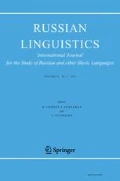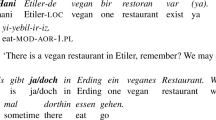Abstract
A long-standing issue in Russian linguistics concerns the noun in paucal constructions like dva goroda ‘two cities’. Is goroda the genitive singular of gorod, a separate ‘numerative case form’, or a ‘paucal number’? Although stress has figured prominently in the debate, corpus data and informant data regarding stress have received little attention. Based on the accentuated part of the Russian National Corpus and two experiments, our article addresses stress in rjad ‘row’, sled ‘trace’, čas ‘hour’, šag ‘step’ and šar ‘sphere, ball’, as well as nouns in which the genitive singular and the nominative plural have identical endings, but different stress placement (e.g. storona ‘side’). First, it is demonstrated that a small group of nouns (rjad, čas, and storona) frequently display stress placement that deviates from the genitive, but that the majority of nouns show genitive stress. Second, an analysis in terms of morphological overdifferentiation is proposed, which accommodates the attested examples of non-genitive stress without abandoning the main rule that paucal numerals normally combine with nouns in the genitive singular. Third, substantivized adjectives and adjectival agreement are argued not to be at variance with the analysis. Finally, it is suggested that the relevant generalizations can be represented in Construction Grammar.
Аннотация
Вопрос о статусе существительного в паукальных конструкциях типа два города является одним из давних вопросов русского языкознания. Является ли форма города формой родительного падежа единственного числа, особой счетной падежной формой или паукальным числом? Несмотря на то что ударение часто упоминается в контексте паукальных форм, корпусные данные и данные, полученные от носителей, пока не получили заслуженного внимания. В основе настоящей статьи лежат результаты анализа данных акцентологического подкорпуса Национального корпуса русского языка, а также двух экспериментов. Мы проанализировали ударение в словах ряд, след, час, шаг и шар, а также в существительных типа сторона, у которых формы родительного падежа единственного числа и именительного падежа множественного числа имеют одинаковое окончание, но разное ударение. Сначала в статье показано, что небольшая группа существительных (ряд, час, сторона) часто употребляются с ударением, отличающимся от ударения родительного падежа, в то время как большинство существительных употребляются с обычным ударением родительного падежа. Далее предлагается анализ в рамках морфологической сверхдифференциации, который позволяет объяснить примеры нестандартного ударения родительного падежа, не отвергая при этом основного правила, согласно которому паукальные числа обычно используются с существительными в родительном падеже единственного числа. В статье также демонстрируется, что субстантивированные прилагательные и адъективное согласование не противоречат предложенному анализу. В заключение показано, что соответствующие обобщения можно представить в рамках грамматики конструкций.
Similar content being viewed by others
Notes
All numbered examples in this article are from the Russian National Corpus (www.ruscorpora.ru). Examples with stress marking are from the accentuated subcorpus, other examples from the main corpus. For the convenience of the reader, the paucal constructions under discussion are italicized in the examples. A source and a year are given for each example.
A terminological clarification is in order. In the following, ‘paucal numeral’ will be used as a cover term for numerals larger than one and smaller than five and ‘paucal construction’ about the combination of such numerals and a noun phrase. ‘Paucal number’ denotes a postulated value in the morphosyntactic category of number, in addition to singular and plural.
The less frequent numerals pol, poltora and the pronominal quantifier oba / obe were not included in the study. When the search results from the Russian National Corpus are exported to a spreadsheet for further analysis, part of the examples are not transferred to the spreadsheet. In order to lose as few examples as possible we carried out a number of searches for specific time spans, numerals and genders, and then combined the resulting files manually.
Notice that percentages for categories with less than 10 members are not reported in this study, since percentages for such small numbers are not meaningful.
We here disregard differences among the five nouns. While a more fine-grained analysis with several constructional schemas is possible, the relevant details do not contribute to the argument, and are therefore not included in the constructional schemas in (5).
‘Mobile d / f’ refers to nouns that according to Zaliznjak ([1967]2002) vacillate between patterns d and f: volna ‘wave’, zarja ‘dawn’, stroka ‘line’, and strofa ‘verse’.
See Nesset, T. (submitted). A long birth: The development of gender-specific paucal constructions in Russian.
Notice that although all informants responded to all three sentences, in a few cases it was difficult to decide from the recording where they placed the stress, and these examples were therefore not included in Table 13.
References
Andersen, H. (2006). Some thoughts on the history of Russian numeral syntax. In H. Goldblatt & N. Shields Kollmann (Eds.), Rus’ writ large: languages, histories, cultures. Essays presented in honor of Michael S. Flier on his sixty-fifth birthday (Harvard Ukrainian Studies, 28(1–4), pp. 57–67). Cambridge.
Bloomfield, L. (1933). Language. New York.
Brown, D. (2007). Peripheral functions and overdifferentiation: The Russian second locative. Russian Linguistics, 31(1), 61–76.
Corbett, G. G. (1993). The head of Russian numeral expressions. In G. G. Corbett, N. M. Fraser, & S. McGlashan (Eds.), Heads in grammatical theory (pp. 11–35). Cambridge. https://doi.org/10.1017/CBO9780511659454.002.
Corbett, G. G. (2007). Canonical typology, suppletion, and possible words. Language, 83(1), 8–42.
Goldberg, A. E. (1995). Constructions. A construction grammar apporach to argument structure. Chicago.
Goldberg, A. E. (2006). Constructions at work. The nature of generalization in language. Oxford.
Goldberg, A. E. (2013). Constructionist approaches. In T. Hoffmann & G. Trousdale (Eds.), The Oxford handbook of construction grammar (pp. 15–31). Oxford.
Goldberg, A. E. (2019). Explain me this. Creativity, competition, and the partial productivity of constructions. Princeton.
Igartua, I., & Madariaga, N. (2018). The interplay of semantic and formal factors in Russian morphosyntax: animate paucal constructions in direct object function. Russian Linguistics, 42(1), 27–55. https://doi.org/10.1007/s11185-017-9188-y.
Jakobson, R. (1936). Beitrag zur allgemeinen Kasuslehre. Gesamtbedeutungen der russischen Kasus. Travaux du Cercle Linguistique de Prague, 6, 240–288.
Janda, L. A., & Clancy, S. J. (2002). The case book for Russian. Bloomington.
Janda, L. A., Lyashevskaya, O., Nesset, T., Rakhilina, E., & Tyers, F. M. (2018). A constructicon for Russian: filling in the gaps. In B. Lyngfelt, L. Borin, K. Ohara, & T. T. Torrent (Eds.), Constructicography. Constructicon development across languages (Constructional Approaches to Language, 22, pp. 165–181). Amsterdam.
Langacker, R. W. (2008). Cognitive grammar. A basic introduction. Oxford.
Madariaga, N., & Igartua, I. (2017). Idiosyncratic (dis)agreement patterns: the structure and diachrony of Russian paucal subjects. Scando-Slavica, 63(2), 99–132. https://doi.org/10.1080/00806765.2017.1390922.
Mel’čuk, I. A. (1985). Poverxnostnyj sintaksis russkix čislovyx vyraženij (Wiener Slawistischer Almanach. Sonderband, 16). Wien.
Michaelis, L. A. (2017). Meanings of constructions. In Oxford Research Encyclopedia of Linguistics. Retrieved from: oxfordre.com (21 January 2019). https://doi.org/10.1093/acrefore/9780199384655.013.309.
Pereltsvaig, A. (2009). As easy as two, three, four? In W. Browne et al. (Eds.), Formal Approaches to Slavic Linguistics (FASL-18). The second Cornell meeting 2009 (Michigan Slavic Materials, 56, pp. 418–435). Ann Arbor.
Steels, L. (2013). Fluid Construction Grammar. In T. Hoffmann & G. Trousdale (Eds.), The Oxford handbook of Construction Grammar (pp. 153–167). Oxford.
Stump, G. (2015). Inflectional paradigms. Content and form at the syntax-morphology interface. Cambridge.
Timberlake, A. (2004). A reference grammar of Russian. Cambridge.
Wade, T. (2001). A comprehensive grammar of Russian. Oxford.
Zaliznjak, A. A. (1977). Grammatičeskij slovar’ russkogo jazyka. Slovoizmenenie. Moskva.
Zaliznjak, A. A. ([1967]2002). Russkoe imennoe slovoizmenenie. S priloženiem izbrannyx rabot po sovremennomu russkomu jazyku i obščemu jazykoznaniju. Moskva.
Zaliznjak, A. A. ([1977]2002). Zakonomernosti akcentuacii russkix odnosložnyx suščestvitel’nyx mužskogo roda. Reprinted as an appendix to the 2002 edition of Russkoe imennoe slovoizmenenie (pp. 478–526). Moskva.
Author information
Authors and Affiliations
Corresponding author
Additional information
Publisher’s Note
Springer Nature remains neutral with regard to jurisdictional claims in published maps and institutional affiliations.
Rights and permissions
About this article
Cite this article
Nesset, T., Nordrum, M. Do Russian paucal numerals govern the genitive? Evidence from stress placement. Russ Linguist 43, 87–105 (2019). https://doi.org/10.1007/s11185-019-09209-7
Published:
Issue Date:
DOI: https://doi.org/10.1007/s11185-019-09209-7




